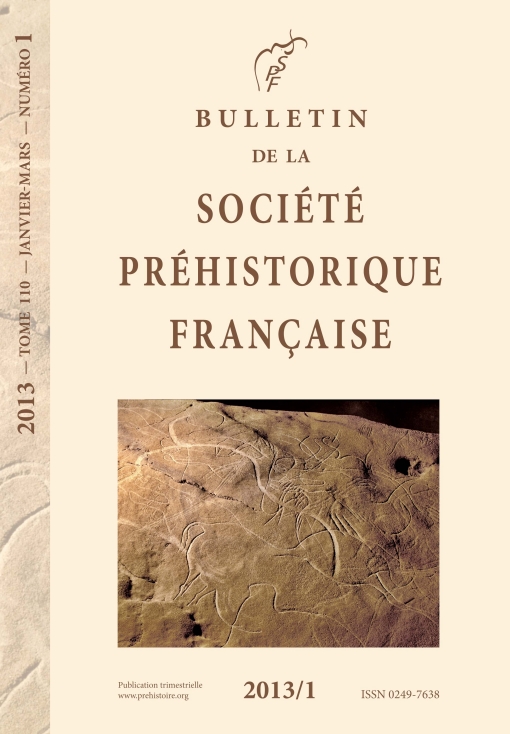02-2013, tome 110, 1, p. 25-46 - B. GASSIN, G. MARCHAND, E. CLAUD, C. GUERET, S. PHILIBERT - Les lames à coches du second Mésolithique : des outils dédiés au travail des plantes ?
Résumé : Durant le VIIe millénaire avant J.-C., des changements importants sont constatés dans les industries lithiques d'Europe occidentale. La production lithique est centrée sur des lamelles régulières, débitées par pression ou percussion indirecte. Ces lamelles sont souvent retouchées pour former une ou plusieurs coches, façonnant parfois des bords denticulés. Nous avons étudié un échantillon de lames à coches provenant de différents sites mésolithiques du VIIe et du VIe millénaire av. J.-C. : Beg-an-Dorchenn, L'Essart, La Grange (Ouest de la France), Noyen-sur-Seine, Choisy-au-Bac (Bassin parisien), Verrebroek Aven Ackers et Oudenaarde (Belgique), Mourre de Sève (Provence), La Grande Rivoire (Alpes), Dammartin-Marpain (Jura). Cette étude préliminaire présente nos premiers résultats, quelques hypothèses fonctionnelles et une discussion sur la place des lames à coches dans les assemblages lithiques. Dans le corpus étudié, les coches sont systématiquement directes et le plus souvent obtenues par flexion. L'analyse fonctionnelle montre que les coches sont utilisées comme outils de raclage. La dissymétrie des polis observés sur la face inférieure et sur la face supérieure (face retouchée) indique que la face supérieure est systématiquement en position de face d'attaque, avec un angle d'attaque voisin de 90° : il s'agit d'un raclage en coupe négative. Cette position d'utilisation est incompatible avec un détachement d'enlèvements d'utilisation en face supérieure. Nous concluons donc que les coches résultent d'une retouche volontaire et non d'un processus d'écaillage en cours d'utilisation. Il apparaît clairement que chaque coche est une zone d'utilisation autonome, utilisée par une faible longueur de tranchant. La variabilité des traces d'usure observées suggère que différents matériaux ont été travaillés, parmi lesquels différents végétaux (bois, plantes souples siliceuses de différentes natures), et, probablement, des matières osseuses. Ainsi, ces outils emblématiques du second Mésolithique résultent d'un processus technique volontaire et correspondent à des finalités fonctionnelles spécifiques. C'est un aspect particulier du renouvellement des techniques qui marque les mutations des sociétés mésolithiques au VIIe millénaire que nos premiers résultats ont ainsi mis au jour.
Abstract: During the VIIth millennium BC, important changes occur in Western Europe. The lithic production focuses on regular bladelets, produced by pressure or indirect percussion. These bladelets are often retouched with one or several notches, sometimes giving them a serrated appearance. Together with trapezoidal geometrics, these laterally notched blades are considered as emblematic tools for the late Mesolithic in Western Europe. Different hypothesis were proposed to explain the origin of these laterally notched blades. J.-G. Rozoy (1978b) thought that there was no definite intentional shaping and suggested that the retouch was a use retouch created during a wood peeling process. During this process, the tools change in shape from blank blades, to laterally irregular retouched blades, and finally notched blades. We tried to give new answers in this old debate through a technological and functional analysis: are notched blades retouched tools or use scars? What are the specific functions of theses notches? This preliminary study presents our first results, some functional hypotheses and a discussion about the place of the notched blades in the lithic toolkit. We have studied a sample of notched blades coming from different Mesolithic sites from the VIIth and VIth millennium BC: Beg-an-Dorchenn, L'Essart, La Grange (Western France), Noyen-sur-Seine, Choisy-au-Bac (Paris Basin), Verrebroek Aven Ackers and Oudenaarde (Belgium), Mourre de Sève (Provence), La Grande Rivoire (Alps), Dammartin-Marpain (Jura). The wear analysis of these tools shows that the notches are the result of a voluntary retouch and are used as scraping tools. In our corpus, all notches are made by direct removals. Most of these removals result from bending fractures. The edge angle, on the very edge, is consequently a rather high angle, up to 90°. The active part of the tool is always the inner concave part of the notches, never the spur between two notches. Edge damage is very limited or absent. Use polishes observed in the notches present different patterns on both faces: on the retouched dorsal face, there is a tiny polish, sometimes more developed with a snow-melting appearance, and on the blank ventral face, there is a marginal polish creating a domed bevel. It is sometimes more invasive and more or less striated. This dissymmetric pattern is the result of a scraping motion with a negative rake angle, the retouched dorsal face being always the rake face, and the ventral face the flank face. Under these conditions, the direct removal cannot result from the use process itself. The limited extension of the polish on the ventral face indicates that the clearance angle, formed by the end flank of the tool and the workpiece surface, is maintained higher than a few degrees, in order to limit the friction with the material. The polish on the dorsal face results from the friction developed as the chips cut by the tool flow over the rake surface of the cutting edge. The variability of the observed wear traces suggests that different materials have been scraped: soft plant with high silica content, soft plants with an abrasive component, wood, and maybe bone or antler. The worked material remains indeterminate on some tools. We can conclude that the notched blades that we studied were involved in different working processes, with different functions, but with a same way of using the tools. The tasks could probably be related to arrows shaping, basketry, strings and thread making. More experimentation is needed to better understand these tools. The comparison with other Mesolithic sites suggests that these activities are important in the technology of Mesolithic societies. Thus, these emblematic tools of the second Mesolithic result from a voluntary technical process and correspond to specific functional purposes. Our first results brought to light a particular aspect of the renewal of the techniques which characterizes the transformations of Mesolithic societies in the VIIth millennium BC.



